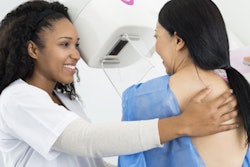
Offering mammograms to low-income patients during an inpatient hospital stay could boost screening rates, according to the findings of a small pilot study published on January 11 in the Annals of Family Medicine.
Low-income women face a number of challenges to attending screening mammogram appointments, including issues with scheduling appointments, transportation, and time off from work. The research team from Massachusetts General Hospital (MGH) in Boston saw offering inpatient mammogram services to select women as one way to reach people who aren't seen as regularly in an outpatient setting.
"Completing preventive screening tests, such as mammograms, during hospitalizations can be one way to help patients who might otherwise miss preventive care," stated Dr. Andrew Hwang, the study's lead author and an internist at MGH, in a press release.
Hwang and colleagues offered screening mammography to patients admitted to the MGH general medicine department between March 2019 and March 2020. To be eligible, patients had to meet the following criteria:
- Insured by Medicaid or a combination of Medicaid and Medicare
- Have a primary care physician affiliated with MGH
- Be overdue for a breast cancer screening
- Not have an outpatient mammography appointment scheduled
A daily report created from electronic medical record data alerted the authors to potential inpatient candidates. The team further reviewed patient charts to ensure the women could complete a mammogram, including being of sound mental status and not medically compromised.
| Characteristics of mammography eligibility in low-income hospital patients | |||
| Ineligible candidates | All eligible candidates | Eligible candidates with a mammogram | |
| Number of patients | 13 | 21 | 17 |
| Mean age | 62 | 59 | 59 |
| Not white | 23% | 33% | 35% |
| Not English speaking | 8% | 10% | 12% |
| Length of hospital stay (days) | 8.2 | 7 | 7 |
The team identified 39 promising patients, of whom 13 were deemed ineligible and 5 refused to participate in the study. The majority of women excluded at this stage were medically unstable or could not stand independently for 10 minutes.
Breast imaging staff contacted the remaining 21 eligible patients to coordinate a screening mammogram on a weekday. Four patients were discharged before a mammogram could be scheduled, resulting in 17 patients who completed a mammogram.
Sixteen of the candidates with a mammogram had a negative screening result. One patient had an inconclusive BI-RADS 0 result and was recommended for additional imaging.
Overall, the authors appeared to successfully identify and perform mammography for patients who would otherwise struggle to undergo screening in an outpatient setting. Despite having a median age of nearly 60, more than one-third of patients (35%) had never had a prior screening mammogram. In addition, the patients were, on average, four years overdue for mammography.
More so, many eligible patients came from backgrounds with historically lower screening mammography rates. More than 10% of the women who underwent inpatient screening mammography did not speak English, and more than one-third were not white.
"The patients who participated in our pilot study faced significant psychosocial challenges to completing outpatient prevention tests," Hwang stated. "Attaining equitable health outcomes for all patients will require innovative solutions that lower the barriers to care by addressing patients' psychosocial needs."
The team sees offering preventive services to hospital inpatients as one, creative solution to improving health equity. Hwang believes that programs like the one described in the study will be increasingly important as payment models change from fee-for-service to value-based payment models.
The authors plan to expand their inpatient mammography program to other hospital departments. They're also looking to offer additional preventive services and cancer screenings to both men and women.
"This targeted strategy has the potential to reduce disparities in cancer screening rates by addressing patients' acute medical needs and their preventive care needs simultaneously," Hwang stated.



















